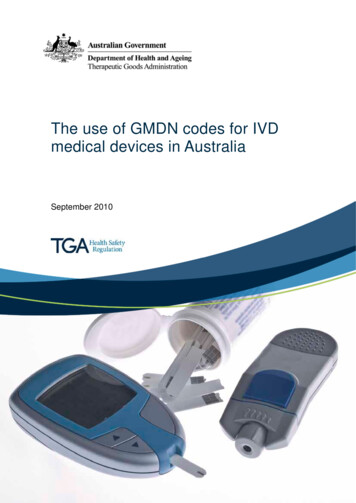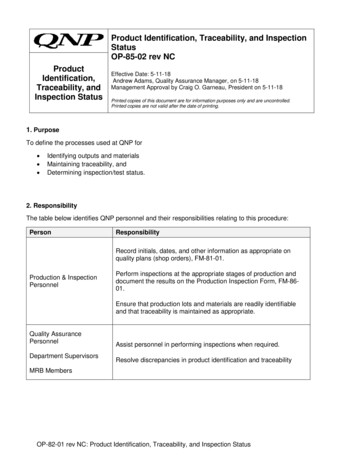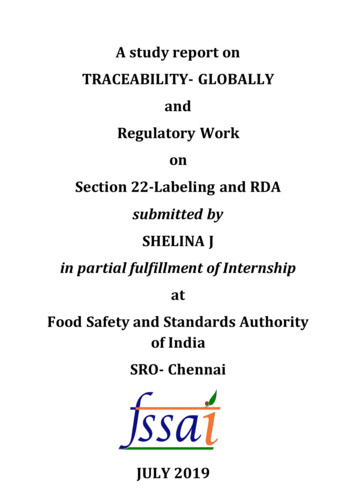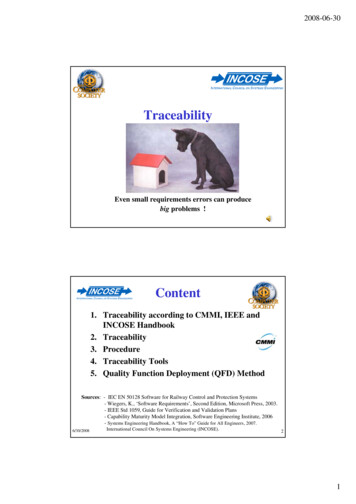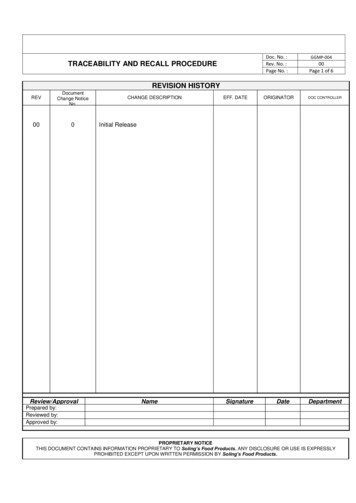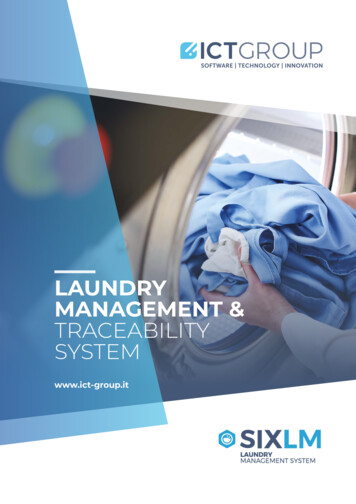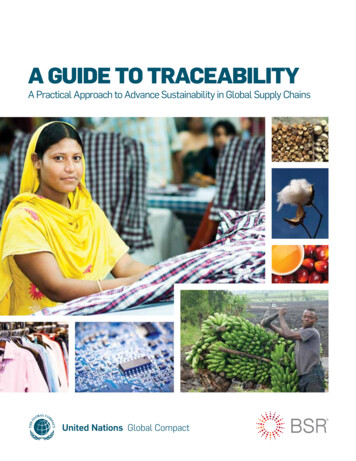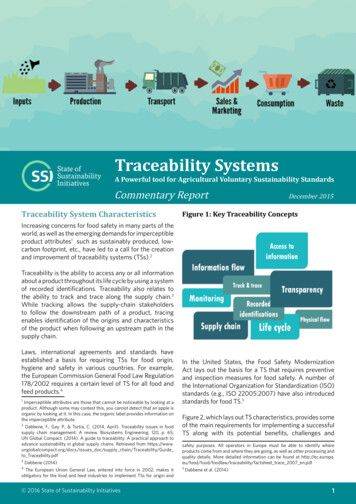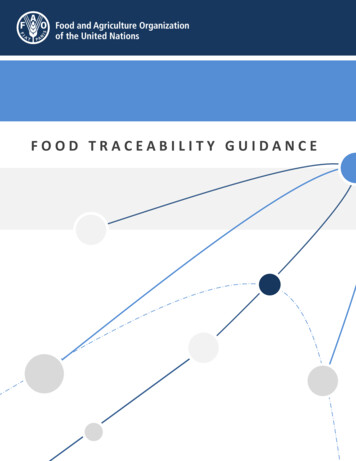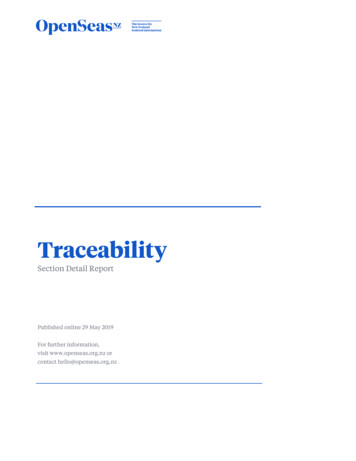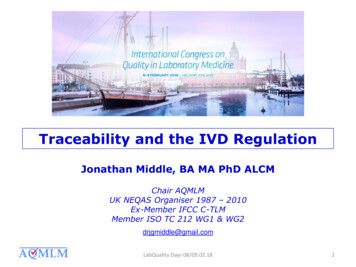
Transcription
Traceability and the IVD RegulationJonathan Middle, BA MA PhD ALCMChair AQMLMUK NEQAS Organiser 1987 – 2010Ex-Member IFCC C-TLMMember ISO TC 212 WG1 & WG2drjgmiddle@gmail.comLabQuality Days 08/09.02.181
Laboratory Medicine exists withina complex web of triangularinter-relationshipsLabQuality Days 08/09.02.182
GovernmentfundingHealthcare ProviderRegulatorpolicy, national standardsProfessionstraining, best practice, auditCliniciansScientistsAdding value for PatientsAccrediting bodiesLaboratoriesstandardscomparabilityEQA providersNotified BodiessafetyIndustrytrueness, traceabilityJCTLM, NMIsLabQuality Days 08/09.02.183
Key Assertions The most important task we undertake in laboratory medicine isto make measurements of clinically important measurands Clinicians rely on them to aid diagnosis and to monitortreatment and thereby improve patient outcomes Patients have implicit trust that their results are correct andwill be interpreted appropriately and consistently by clinicians Results of measurements must therefore be accurate andcomparable across time & geography, and proven to addvalue to the clinical episode For these requirements to be realised, a referencemeasurement system must exist which enables suppliers ofanalytical methods to create products which are metrologicallytraceable to an established standard and are clinically validLabQuality Days 08/09.02.184
VIM 3.0 definitionLabQuality Days 08/09.02.185
Four things to start with LabQuality Days 08/09.02.186
1. The Traceability ChainLabQuality Days 08/09.02.187
LabQuality Days 08/09.02.188
2. Traceability & SpecificityProfessor Lothar Siekmann, .htm“An inevitable precondition for the establishing of traceable resultsto calibrators and control materials is the specificity of themeasurement procedures applied. Results of measurementcannot be traceable when the procedure applied partiallydetects components which are not consistent with thedefinition of the measurand.The complete traceability chain is valid only for thosemeasurable quantities that can have a value expressed in SIunits. When primary or secondary calibrators are not available,the traceability chain for many measurands in laboratory medicineends at a lower level, e.g. at the manufacturer's standingmeasurement procedure.“Note – the term ‘selectivity’ is now preferred.LabQuality Days 08/09.02.189
3. The crucial distinction betweentwo types of analyteType 1Well-defined, single chemical entities with determined valuestraceable to SI units, and internationally recognized referenceprocedure-defined measurands.Type 2Less well-defined entities or heterogeneous mixtures ofprecursors / isoforms / fragments with or without biologicalactivity, that are not SI-traceable and/or no internationallyrecognized reference measurement procedures exist that areapplicable to patient samples.LabQuality Days 08/09.02.1810
Roger Ekins taught us that ‘Analytical’ assaysestimate a defined analyte in systems which give results inmethod-independent units of amount of the analyteApplicable to Type 1 analytes - we can truly measure these‘Comparative assays’estimate undefined 'analyte' in systems which give results inmethod-dependent units of effect of the 'analyte' in that systemApplicable to Type 2 analytes - we cannot truly measure theseOnly about 20% of the quantities we ‘measure’ inLaboratory Medicine are Type 1LabQuality Days 08/09.02.1811
4. JCTLM – Joint Committee forTraceability in Laboratory MedicineLabQuality Days 08/09.02.1812
LabQuality Days 08/09.02.1813
http://www.bipm.org/utils/en/pdf/Traceability in LabMed.pdfThis document is particularly recommended!LabQuality Days 08/09.02.1814
LabQuality Days 08/09.02.1815
LabQuality Days 08/09.02.1816
LabQuality Days 08/09.02.1817
I’d also like to mention this EQAservice for reference laboratoriesoperating reference methodsregistered with JCTLM LabQuality Days 08/09.02.1818
IFCC RELAhttp://www.dgkl-rfb.de:81/LabQuality Days 08/09.02.1819
Traceability is a key requirementof ISO 15189LabQuality Days 08/09.02.1820
ISO 15189 – 15.3.1.4 Equipment calibration and metrological traceabilityThe laboratory shall have a documented procedure for the calibrationof equipment that directly or indirectly affects examination results.This procedure includes:a) taking into account conditions of use and the manufacturer’sinstructions;b) recording the metrological traceability of the calibration standardand the traceable calibration of the item of equipment;c) verifying the required measurement accuracy and the functioning ofthe measuring system at defined intervals;d) recording the calibration status and date of recalibration;e) ensuring that, where calibration gives rise to a set of correctionfactors, the previous calibration factors are correctly updated;f) safeguards to prevent adjustments or tampering that might invalidateexamination results.LabQuality Days 08/09.02.1821
ISO 15189 – 2Metrological traceability shall be to a reference material orreference procedure of the higher metrological order available.NOTE Documentation of calibration traceability to a higher orderreference material or reference procedure may be provided by anexamination system manufacturer. Such documentation is acceptableas long as the manufacturer’s examination system and calibrationprocedures are used without modification. Where this is not possibleor relevant, other means for providing confidence in the results shallbe applied, including but not limited to the following: use of certified reference materials; examination or calibration by another procedure; mutual consent standards or methods which are clearlyestablished, specified, characterized and mutually agreed upon byall parties concerned.LabQuality Days 08/09.02.1822
Traceability in laboratory medicineis governed by ISO 17511:2003LabQuality Days 08/09.02.1823
ISO 17511:2003 In vitro diagnostic medical devices —Measurement of quantities in biological samples —Metrological traceability of values assigned tocalibrators and control materialsDepending on the possibility of metrological traceability to SI and on theavailability of various metrological levels of measurement procedures andcalibrators, the following five typical upper ends of the metrologicaltraceability chain may be identified.a) Quantities for which results of measurements aremetrologically traceable to SI.A primary reference measurement procedure and one or more (certified)primary reference materials (used as calibrators) are available. Theselevels exist for approximately 25 to 30 types of quantity having well definedcomponents, e.g. some electrolytes, metabolites, steroid hormones, and some thyroidhormones. These types of quantity cover a large proportion of the routine resultsprovided by medical laboratoriesLabQuality Days 08/09.02.1824
b) Quantities for which results of measurements are notmetrologically traceable to SI.1) An international conventional reference measurement procedure (see3.12) (which cannot be called a primary reference measurement procedure)and one or more international conventional calibration materials (see3.11) with values assigned by that procedure are available.2) An international conventional reference measurement procedure is availablebut no international conventional calibration materials. These conditions applyfor about 30 types of quantity with components such as haemostatic factors3) One or more international conventional calibration materials (used ascalibrators) with a protocol for value assignment are available, but nointernational conventional reference measurement procedure. These conditionsapply for over 300 types of quantity, e.g., for quantities referred to World HealthOrganization's International Standards, such as protein hormones, some antibodies,and tumour markers4) Neither reference measurement procedure nor reference materials forcalibration are available. The manufacturer can establish 'in-house'measurement procedure(s) and calibrator(s) to support value assignmentto his product calibrator. These conditions apply for about 300 types of quantity withcomponents such as tumour markers and antibodiesLabQuality Days 08/09.02.1825
Traceability is a requirement ofthe original EU IVD Directive LabQuality Days 08/09.02.1826
IVD Directive 98/79/ECExcerpts related to the requirement for traceabilityANNEX I: Essential RequirementsA. General requirements: The traceability of values assigned tocalibrators and/or control materials must be assured throughavailable reference measurement procedures and/or availablereference materials of a higher orderANNEX III: EC Declaration of Conformity3. The technical documentation . must include in particular:adequate performance evaluation data showing the performancesclaimed by the manufacturer and supported by a referencemeasurement system (when available), with information on thereference methods, the reference materials, the known referencevalues, the accuracy and measurement units used;LabQualityDays 08/09.02.18EQALM-20227
I have always been rather concerned thatboth the IVDD and ISO 17511:2003 talkabout the traceability of values assigned tocalibrants and controls and not the endresult for the patient.We shall see if this situation has now beenimproved!LabQuality Days 08/09.02.1828
The ‘new’ ISO 17511I can only share with you some proposals about the currentrevision, as we are bound by strict ISO confidentiality rules!Title of proposed revision:ISO 17511:201x. In vitro diagnostic medical devices —requirements forestablishing metrological traceability of values assigned to calibrators,trueness control materials and human samples.JustificationISO17511:2003 and ISO 18153:2003 have now been in place for more than12 years, and the expert technical community has recommended toISO/TC212/WG2 several opportunities to improve these standards. Theseopportunities include:1) clarification within the ISO 17511 standard that there is an end-userexpectation that metrological traceability does not end with thecalibrator, and that final reported results on patient samples are alsoexpected to be metrologically traceable to the highest orderavailable metrological reference for a measurand;LabQuality Days 08/09.02.1829
The ‘new’ ISO 175111) improvement (for clarity) of the descriptions of the potential approaches andmodels that may be applied in establishing a calibration hierarchy, as afunction of state of the art and availability of higher order references;2) inclusion of a model calibration hierarchy that is compatible with theimplementation of a harmonization protocol to support standardization ofmultiple measurement procedures for measurands without higher orderreference measurement procedures and reference materials; and3) address a recommendation that ISO 18153 content concerning establishingmetrological traceability for enzyme catalytic concentrations mightinstead be incorporated into a revised ISO 17511, thereby eliminating theneed for ISO to maintain two standards, and also minimize cost to end userswho might otherwise need to purchase two standards instead of one.So that is all good!LabQuality Days 08/09.02.1830
The EU IVDD has now beenrevised and strengthened tobecome the new IVD RegulationLabQuality Days 08/09.02.1831
TimelineThe European Medical Device Regulations (MDR 2017/745) and InVitro Diagnostic Regulations (IVDR 2017/746) entered into force asof May 26, 2017.The Regulations’ entry into force is the last milestone before fullimplementation of the MDR in May 2020 and the IVDR in May2022.The official three-year countdown to the MDR’s date of application(full implementation)—May 26, 2020—has begun. By that date,medical device manufacturers active in Europe will have to be fullycompliant with the MDR. The five-year countdown to the IVDR’sdate of application (May 26, 2022) has also begun.In the shorter term, European Notified Bodies may begin applyingfor designation under the MDR and IVDR starting November 26,2017.LabQuality Days 08/09.02.1832
Key Elements - 1IVDs are now defined as:a reagent, reagent product, calibrator, control material, kit, instrument,apparatus, equipment, software or system, whether used alone or incombination, intended by the manufacturer to be used in vitro for theexamination of specimens, including blood and tissue donations, derivedfrom the human body, solely or principally for the purpose of providinginformation: concerning a physiological or pathological state;concerning a congenital abnormality;concerning the predisposition to a medical condition or a disease;to determine the safety and compatibility with potential recipients;to predict treatment response or reactions;to define or monitor therapeutic measures.LabQuality Days 08/09.02.1833
Key Elements – 2How the IVDR Impacts Device Classification The IVDR substantially changes the mechanism by which IVDs may bearthe CE mark.A new risk-based classification scheme will replace the "general IVD"category with four new device classes: A, B, C, and D (lowest risk tohighest risk, respectively).Classes B through D will require an assessment of the technicaldocumentation by a Notified Body. This technical documentation mustinclude three types of clinical evidence:Scientific Validity: association of an analyte to a clinical condition orphysiological stateAnalytical Performance: ability of an IVD to correctly detect andmeasure the analyte (LOD, LOQ, accuracy, precision andreproducibility)Clinical Performance: ability of the device to yield results that relate to aparticular clinical condition for the intended use and in accordance withtarget population, and to the intended user (if applicable)LabQuality Days 08/09.02.1834
where Traceability is mentionedin the new IVDR Grey boxes refer to ‘general’ traceability – we can skipover these; blue boxe
Metrological traceability shall be to a reference material or reference procedure of the higher metrological order available. NOTE Documentation of calibration traceability to a higher order reference material or reference procedure may be provided by an examination system manufacturer. Such documentation is acceptable as long as the manufacturer¶s examination system and calibration .File Size: 1MBPage Count: 43
